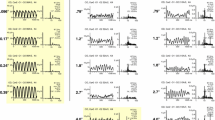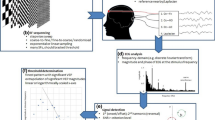Abstract
Sixty local VEP records, called the multifocal VEP (mfVEP), can be obtained over a wide retinal area. From subject-to-subject, from day-to-day, and from location-to-location, these records can vary in quality presenting a challenge to quantitative analyses. Here three procedures are described for specifying the quality of mfVEP recordings in terms of signal-to-noise ratios. Monocular mfVEPs were recorded in two, 7-min runs. A ‘2-run signal-to-noise ratio’ (2rSNR) was obtained as {[RMS(RunA+RunB)]/[RMS(RunA–RunB)]}–1, where RMS is the root-mean-square amplitude of the response over the period from 45 to 150 ms (signal window). Two ‘noise-window signal-to-noise ratios’ were obtained with the same numerator as the 2rSNR but with the denominators based upon the RMS of a signal-free window from 325 to 430 ms. In one case, inSNR, the denominator was the RMS of the record's noise window and in the other case, mnSNR, the denominator was the mean of the RMS amplitudes of all the signal-free noise windows for the subject. The SNRs were related to false-positive rates (i.e., detecting a signal when none was present) by recording mfVEPs with some of the sectors of the display occluded. In particular, the outer three rings (36 sectors) of the display were occluded so that only noise was recorded; false-positive rates for different values of SNR were calculated. The 2rSNR had the highest false-positive rate largely due to alpha in the records of some subjects. The mnSNR had a lower false-positive rate than did the inSNR because there was little correlation between the RMS of the noise in the signal-free window and the RMS of the noise within the signal window. Use of the mnSNR is recommended over the 2rSNR, especially where alpha contamination can not be eliminated. Ways to improve the SNR of the records are discussed.
Similar content being viewed by others
References
Abe H, Iwata K. Checkerboard pattern reversal VEP in the assessment of glaucomatous field defects. Acta Soc Ophthalmol Jpn 1976; 80: 829–41.
Bobak P, Bodis-Wollner I, Harnois C, Maffei L, Mylin L, Podos S, Thornton J. Pattern electroretinograms and visual-evoked potentials in glaucoma and multiple sclerosis. Am J Ophthal 1983; 96: 72–83.
Regan D, Spekreijse H. Evoked potentials in vision research 1961-1986. Vis Res 1986; 26: 1461–80.
Baseler HA, Sutter EE, Klein SA, Carney T. The topography of visual evoked response properties across the visual field. Electroencephalogr Clin Neurophysiol 1994; 90: 65–81.
Sutter EE. The fast m-transform: a fast computation of cross-correlations with binary m-sequences. Soc Ind Appl Math 1991; 20: 686–94.
Sutter EE, Tran D. The field topography of ERG components in man-I. The photopic luminance response. Vis Res 1992; 32: 433–66.
Klistorner AI, Graham SL, Grigg JR, Billson FA. Multifocal topographic visual evoked potential: Improving objective detection of local visual field defects. Invest Ophthalmol Vis Sci 1998; 39: 937–50.
Hood DC, Zhang X, Greenstein VC, Kangovi S, Odel JG, et al. An interocular comparison of the multifocal VEP: A possible technique for detecting local damage to the optic nerve. Invest Ophthalmol Vis Sci 2000; 41: 1580–87.
Hood D C, Zhang X. Multifocal ERG and VEP responses and visual fields: comparing disease-related changes. Doc Ophthal 2000; 100: 115–37.
Graham SL, Klistorner AI, Grigg JR, Billson FA. Objective VEP perimetry in glaucoma: Asymmetry analysis to identify early deficits. J Glaucoma 2000; 9: 10–9.
Hood DC, Odel JG, Zhang X. Tracking the recovery of local optic nerve function after optic neuritis: A multifocal VEP study. Invest Ophthalmol Vis Sci 2000; 41: 4032–38.
Brindley GS. The variability of the human striate cortex. Proc Physiol Soc 1972; 1–3P.
Stensaas SS, Eddington DK, Dobelle WH. The topography and variability of the primary visual cortex in man. J Neurosurg 1974; 40: 747–55.
Steinmetz H, Gunter F, Bernd-Ulrich M. Craniocerebral topography within the international 10-20 system. Electroencephalogr Clin Neurophysiol 1989; 72: 499–506.
Zhang X, Hood DC, Greenstein VC, Odel JG, Kangovi S, Liebmann JM. Detecting field defects with multifocal VEPS: Two eyes are better than one. Invest Ophthalmol Vis Sci (abstract) 1999; 40: S81.
Klistorner AI, Graham SL. Objective perimetry in glaucoma. Ophthalmology 2000; 107: 2283–99.
Schimmel H. The (+) reference: Accuracy of estimated mean components in average response studies. Science 1967; 157: 92–4
Meigen T, Bach M. On the statistical significance of electrophysiological steady-state responses. Doc Ophthalmol 1999; 92: 207–32.
Hood DC, Zhang X, Hong JE, Chen CS. Quantifying the benefits of additional channels of multifocal VEP recording. Doc Ophthalmol 2002; 104: 303–320.
Klistorner AI, Graham. SL Multifocal pattern VEP perimetry: analysis of sectoral waveforms. Doc Ophthalmol 1999; 98: 183–96.
Zhang X, Hood DC. Quantitative methods for comparing changes in multifocal visual evoked potentials to visual field defects. Invest Ophthalmol Vis Sci (abstract) 2000; 41: S292.
Zhang X, Hong JE, Hood DC. Quantitative assessment of the quality of multifocal VEP records: Bigger is not necessarily better. Invest Ophthal Vis Sci (abstract) 2001; 41: in press.
Author information
Authors and Affiliations
Rights and permissions
About this article
Cite this article
Zhang, X., Hood, D.C., Chen, C.S. et al. A signal-to-noise analysis of multifocal VEP responses: an objective definition for poor records. Doc Ophthalmol 104, 287–302 (2002). https://doi.org/10.1023/A:1015220501743
Issue Date:
DOI: https://doi.org/10.1023/A:1015220501743




